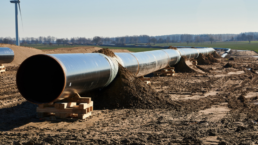After a leak in Sulphur, Louisiana, experts and residents express grave concerns about the fossil fuel industry’s carbon capture plans — and its mounting efforts to curb federal oversight.
by Emily Sanders, ExxonKnews
A carbon dioxide pipeline rupture in the small village of Satartia, Mississippi, sent nearly 50 people to the hospital with “zombie”-like conditions in 2020, and now another major leak from a pipeline in Sulphur, Louisiana, has once again exposed the risks carbon dioxide pipelines pose to communities in their path.
Soon, pipelines like this could be coming to cities and towns throughout the country. Spurred by federal tax incentives from the Biden Administration, the fossil fuel industry is planning to build tens of thousands of miles of carbon dioxide (CO2) pipelines across the United States for experimental carbon capture and storage — a process aimed at sequestering carbon emissions from power plants, sending it through pipelines, and injecting it underground.

While regulators are working to craft updated safety rules for these pipelines, major fossil fuel companies and their trade groups — including Chevron, ConocoPhillips, the American Petroleum Institute, and the Liquid Energy Pipeline Association — have launched a lobbying blitz to scale back regulations and target the regulators themselves so they can construct new pipelines as quickly as possible.
Carbon dioxide is an asphyxiant. Upon entering the atmosphere during a pipeline leak or rupture, it can travel long distances, shut down vehicles, and sicken, suffocate, or even kill people and wildlife.
Recent Posts
‘Unconstitutional. Unethical. Authoritarian.’ ICE Bars Millions Of Immigrants From Bond Hearings
July 18, 2025
Take Action Now One watchdog said the new policy “seems like a blatant attempt to stop them from exercising their right to due process.”……
Americans Are Not Nearly Alarmed Enough About Climate Change
July 18, 2025
Take Action Now Americans still don’t comprehend how imminent, dangerous, and far-reaching the threat is—and journalists are partly to blame.By…
The IRS Is Building A Vast System To Share Millions Of Taxpayers’ Data With ICE
July 17, 2025
Take Action Now ProPublica has obtained the blueprint for the Trump administration’s unprecedented plan to turn over IRS records to Homeland Security…
Israel’s Sudden Assault On Syria Is Unchecked Aggression
July 17, 2025
Take Action Now Jerusalem is bombing Damascus and threatening al-Sharaa’s rule, while Washington was hoping to help the nascent government on…




